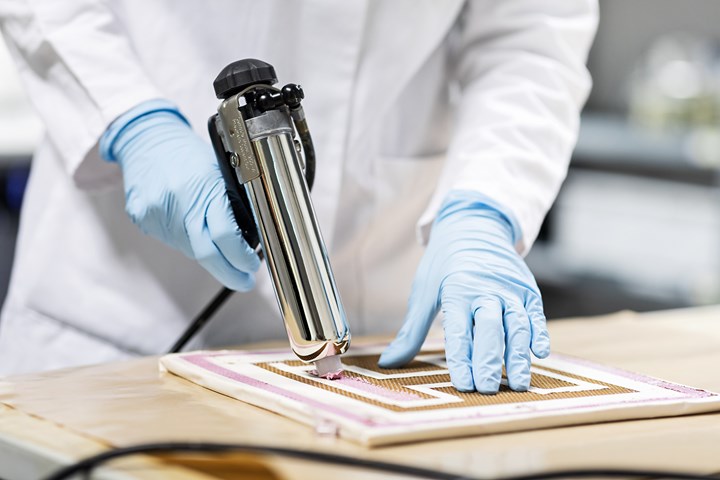Henkel develops REACH-compliant structural adhesive for aircraft interiors
FST-certified Loctite EA 9365FST reinforces and bonds thermoplastic and thermoset substrates and can serve as a matrix resin on fiberglass to strengthen the thin walls of thermoplastic assemblies

Photo Credit: Henkel
Henkel Adhesive Technologies (Düsseldorf, Germany), a leader in structural adhesives and surface treatments for the aircraft OEM and maintenance, repair and operations (MRO) industries worldwide recently developed Loctite EA 9365FST, a new two-part epoxy adhesive that reinforces and bonds thermoplastic and thermoset substrates and can serve as a matrix resin on fiberglass to strengthen the thin walls of thermoplastic assemblies. Developed for use in aircraft interiors, the halogen and antimony-free adhesive is said to meet industry fire retardancy, smoke density and toxicity (FST) requirements, is REACH- and EH&S-compliant worldwide and is qualified to Boeing (Chicago, Ill., U.S.) process specification BAC 5568.
According to Henkel, Loctite EA 9365FST cures in only two hours at 70°C (158°F) or in seven days at room temperature. The adhesive offers good mechanical performance when bonding properly treated thermoplastics and thermosets to a range of other substrates. This user-friendly epoxy also reportedly provides an excellent balance of adhesion performance and FST compliance. Designed not to yellow over time, the product is paintable, delivering good color performance with less show-through than older adhesive formulations.
When used as a matrix resin, Henkel says Loctite EA 9365FST easily wets out fiberglass, strengthening thin thermoplastic assembly walls for enhanced structural support in interior applications including wall, ceiling and floor panels; compartments and cabin stowage; galleys; lavatories; and seating. The product is available globally and has targeted applications in commercial aviation, defense and rail applications.
Related Content
-
Bladder-assisted compression molding derivative produces complex, autoclave-quality automotive parts
HP Composites’ AirPower technology enables high-rate CFRP roof production with 50% energy savings for the Maserati MC20.
-
Revisiting the OceanGate Titan disaster
A year has passed since the tragic loss of the Titan submersible that claimed the lives of five people. What lessons have been learned from the disaster?
-
Otto Aviation launches Phantom 3500 business jet with all-composite airframe from Leonardo
Promising 60% less fuel burn and 90% less emissions using SAF, the super-laminar flow design with windowless fuselage will be built using RTM in Florida facility with certification slated for 2030.



